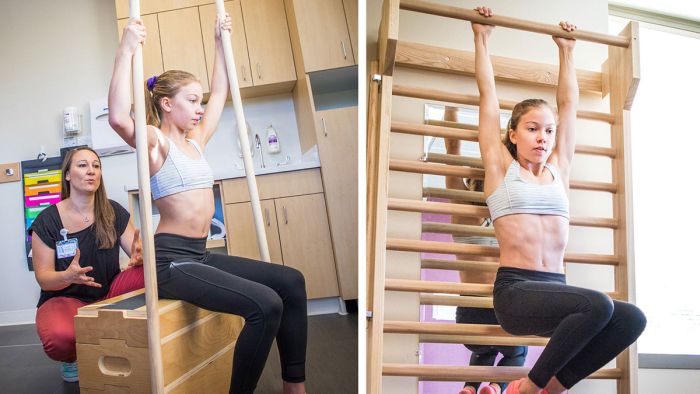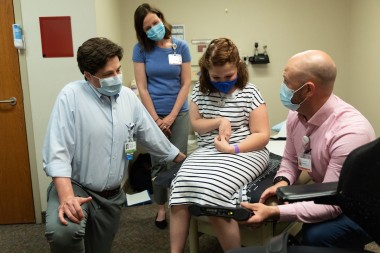
Alexis has a team that includes Gillette pediatric orthopedic surgeon, Dan Miller, MD, researcher Sara Morgan and seating specialist Nick Anderson.
A diagnosis of scoliosis, a curvature of the spine, can be upsetting for a family but Gillette pediatric orthopedic surgeon, Dan Miller, MD, wants to provide reassurance. “Most people who have scoliosis don’t necessarily need treatment. It’s important to see a medical professional so you can monitor and watch the condition to make sure that it doesn’t get to the point where it would adversely affect someone’s life,” Miller says.
“At Gillette we have the whole pallet of scoliosis care and specific therapies. We want to help patients avoid back pain or limitations,” Miller adds. Although he is an expert spine surgeon, Miller says surgery is usually not called for and in fact, bracing, physical therapy and other new options are all part of the comprehensive scoliosis care plan at Gillette.
June is National Scoliosis Awareness Month. Gillette Children's is nationally and internationally recognized for its leadership in pediatric orthopedics and in the treatment of spine conditions, including scoliosis.
Miller, specializes in scoliosis care and says, “Gillette is the leader in Minnesota for pediatric scoliosis care and there’s a good reason for that distinction.” Miller’s spine and orthopedic colleagues as well as the entire Gillette team are specially trained to help pediatric patients. “Many people have a role in taking care of patients,” Miller says. “Our nurses, anesthesiologists, imaging technicians, physician assistants and therapists have the expertise and experience not found in many other health care institutions. It makes a real difference in the care.”
The Gillette spine team includes several physical therapists specially trained in the Barcelona Scoliosis Physical Therapy School (BSPTS) Schroth Based Method. The exercises in the Schroth Method are customized for each child to reduce the symptoms of scoliosis. This nonsurgical scoliosis treatment option aims to elongate and stabilize the spine in a three-dimensional plane. It was developed by Katharina Schroth in the late 1800s in Germany. This treatment is not appropriate for every patient and requires a long-term commitment to physical therapy and exercise.
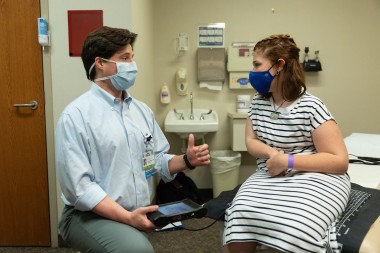
Gillette pediatric orthopedic surgeon, Dan Miller, MD, speaks to Alexis Verzal. Their relationship is built on trust and good communication.
New treatments and surgical options
Miller says the on-site Gillette Orthotics, Prosthetics and Seating experts are key members of the team to make sure spine patients have access to the latest in bracing technology and other devices. “There are newer forms of bracing that we’re embracing,” Miller says. “For example, we sometimes use nighttime braces that are specifically designed to be worn only at night. This can decrease the stress, apprehension and burden of wearing a brace.”
The Verzal family from Lincoln, Nebraska travel to Gillette and say the 6-hour drive is worth it so their 14-year-old daughter, Alexis, can receive expert care. Recently the family spent a day meeting with Dr. Miller and various Gillette providers, including seating specialist, Nick Anderson. Alexis has been having some discomfort when she sits in her wheelchair and Anderson brought a special seating mat and equipment to see how to make her more comfortable.
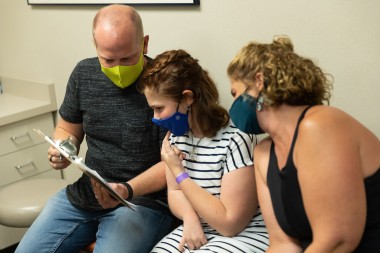
Brandon and Tiffany Verzal say the long drive from Lincoln, Nebraska to Gillette's main campus in St. Paul, Minnesota is worth it so their daughter can receive excellent care.
"The collaboration at Gillette is incredible."
“We’ve been coming to Gillette two to three times a year since Alexis was two,” her father, Brandon Verzal, recalls. “The collaboration at Gillette is incredible. You’re not talking to a series of separate doctors. You’re talking to a team that communicates well and everyone is in on the plan for your child.”
Alexis suffered a Traumatic Brain Injury (TBI) at daycare when she was 14-months old. At the time, the Verzal family lived in Texas and Alexis’ medical condition prompted their to move back home to Nebraska. Once Alexis was stabilized her parents, Brandon and Tiffany, began to research the best place for her to receive ongoing care. “We have good medical resources in Nebraska,” Tiffany says. “But kids like Alexis are rare and the doctors are not familiar with lots of treatment options. At Gillette, kids who are complex like Alexis are common.”
Alexis is scheduled for spine surgery to help with scoliosis with Dr. Miller later this summer. She’s also received care from Gillette pediatric orthopedic surgeons, Tom Novacheck, MD and Deborah Quanbeck, MD. When she was 5 years old, she received tendon lengthening in her hand from pediatric orthopedic hand surgeon, Ann Van Heest, MD. Alexia also sees pediatric neurosurgeon, Peter Kim, MD for an intrathecal baclofen (ITB) pump that is surgically implanted to deliver medication directly into the spinal fluid to help reduce spasticity.
“All of the Gillette providers are excellent, and we really appreciate Dr. Miller,” Tiffany Verzal says. “He’s never rushed and answers all our questions. We also appreciate his sense of humor and how he speaks to our daughter. He really tries to build a relationship and trust with Alexis.”
The Gillette team has a variety of options if a patient needs a surgical intervention for scoliosis treatment. “We have a whole suite of surgical care options,” Miller says. “This includes traditional spinal fusions, as well as spinal fusion that can include some computer-assisted navigation, as well as vertebral body tethering or growth modulation—this is the newest form of scoliosis care for idiopathic scoliosis. It’s very exciting.”
Miller cautions there’s not a standard plan of care for each scoliosis patient because the amount or degree of the curve can vary greatly.
Idiopathic scoliosis is the most common form and is often called adolescent scoliosis or AIS. It accounts for 85 percent of all cases and is named “idiopathic” because the cause is unknown. Neuromuscular scoliosis occurs in children who have conditions such as spina bifida, cerebral palsy, muscular dystrophy or other neuromuscular conditions. Congenital scoliosis is a relatively rare form and starts as the spine forms before a child is born. Spinal bones are not fully formed or some vertebrae might be fused together in congenital scoliosis. Juvenile scoliosis is another uncommon form that develops during childhood. Degenerative scoliosis typically develops later in life as the joints in the spine wear down of develop osteoporosis.
Gillette Children's spine research programs focus on long-term outcomes in patients who have various types of scoliosis.
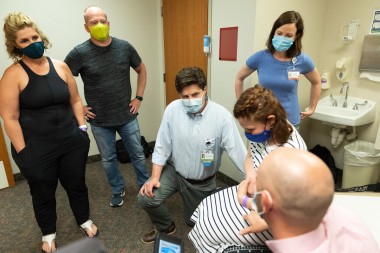
The Verzal family say they appreciate the time Gillette experts spend explaining care options.
 Home Page
Home Page
